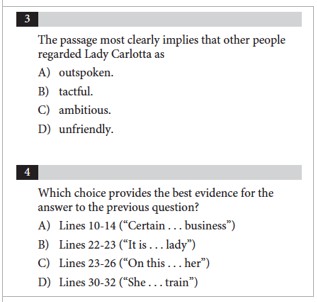Choosing between the SAT and the ACT: Quantitative (Math/Science) Considerations Our Testing Strategist, Mr. Sean…
SAT or ACT? Part 1

Choosing between the SAT and the ACT: Reading/Writing/English Sections Analysis
Our Testing Strategist, Mr. Sean Quinn, shares his insights on the complexities of both the SAT and the ACT so that you can make an informed decision about which is the best fit. Here in Part 1, he will focus on the Reading, Writing and English sections of the SAT and the ACT and the important differences that may impact your outcomes.
The Tests: Scoring Nuances
If you plan to apply to universities in the United States, you need to take one of two standardized tests: the SAT or the ACT. In this blog post, he will walk you through the major differences between the Reading/Writing/English sections of these exams and offer some advice that may help you decide which test is the better fit for you.
The SAT consists of two sections: Evidence-Based Reading and Writing (scored on a scale of 200-800) and Math (scored on a scale of 200-800).
- The combination of the two sections results in an overall score ranging from 400-1600. Highly selective schools and colleges prefer to see at least one of these scores as an 800, and the overall score as 1550 or higher.
- Most institutions will Super Score for the SAT and combine the highest scores from multiple test dates.
For example, if a student earned the following results on three test dates:
EBRW: 600, M: 790 on September 25th
EBRW: 780, M: 760 on October 31st
We would Super Score for EBRW: 780, M: 790.
On the SAT, your Evidence-Based Reading and Writing score is the sum of two sections: SAT Reading and SAT Writing & Language.
The SAT Reading section consists of 5 passages with 10-11 questions each for a total of 52 questions (to be completed within 65 minutes). This section tests your ability to understand the main ideas of a passage, link claims with evidence, make inferences based on the passage, define vocabulary words in context, and synthesize information within and between passages as well as between a passage and graphs/figures.
Meanwhile, the SAT Writing and Language section includes 4 passages with 11 questions each for a total of 44 questions (to be completed within 35 minutes). This section tests your knowledge of grammar rules, language use, and rhetorical strategies.
The ACT consists of four sections: Math, Science, Reading and English (each section is scored on a scale of 1-36).
- A Composite Score is generated from the average of these four sections.
- Some institutions permit Super Scoring on the ACT, which is the combination of the top section scores from several different test dates for the highest possible Composite Score.
For example, if a student earned the following results on two test dates:
Math: 24, Science: 35, Reading: 24, English: 33 on September 10th
Math: 34, Science: 30, Reading: 36, English: 25 on October 18th
We would Super Score to Math: 34, Science: 35, Reading: 36, English: 33.
On the ACT, you receive a separate score (on a scale of 0-36) for each of the Verbal sections: ACT Reading and ACT English.
The ACT Reading section consists of 4 passages of 10 questions each for a total of 40 questions (to be completed in 35 minutes). The competencies tested are similar to those tested on the SAT Reading.
The ACT English section consists of 75 questions (to be completed in 45 minutes), and, like SAT Writing and Language, tests your knowledge of grammar rules, language use, and rhetorical strategies.
If you’re wondering which test would be a better fit for you, your best bet is to take both an SAT diagnostic and an ACT diagnostic — before you begin test prep.
You may find you have a natural affinity for one test over the other, or you may discover that you’re stronger in Writing/English on one test and Math on another. Either way, these diagnostics that utilize actual exam questions provide useful data about where your strengths and struggles lie, and how you and your tutor can work together to maximize your overall score.
Key differences: SAT Reading/Writing vs. ACT Reading/English Sections
Nearly all universities in the United States accept both SAT and ACT scores and do not favor either test. While I can’t recommend one test over the other without seeing your diagnostic scores, I can point out a few key differences between the Verbal sections of these exams that may influence which is the better fit for you.
1. Timing is significantly tighter on ACT Reading than on SAT Reading
ACT Reading gives students less time per question than does SAT Reading; on the ACT, you’ll have an average of roughly 50 seconds per Reading question, whereas on the SAT, you’ll have an average of 1 minute, 15 seconds per question. Those extra 25 seconds per question can make a huge difference! If you struggle to complete the Reading section on time, the SAT may be a better fit for you—but keep in mind the following caveats:
First, as you’ll see below in Difference 2, just because the SAT Reading passages are shorter, doesn’t mean they’re easier (in fact, the opposite is often true!).
Second, The Admissions Project’s tutors have loads of experience helping students test out different reading strategies that optimize both speed and accuracy. It’s very common for students to struggle with timing on the diagnostic exams, and our tutors can help to troubleshoot that problem starting in the very first session. Put differently, struggling with timing on the diagnostic exam should not automatically rule out the ACT.
2. SAT allows more time per question, but requires higher-level reading proficiency and comprehension
In other words, you may be less crunched for time on the SAT than the ACT, but you may find that the SAT questions themselves are more difficult than the ACT questions. As mentioned above, SAT Reading allows more time per question than ACT Reading does—however, SAT Reading questions often require a more sophisticated and nuanced understanding of the passage compared to ACT Reading questions. One is not better or worse than the other; they are simply different, and therefore require different approaches. Your tutor will tailor your program to your individual needs, as well as to the strategies that have proven most effective on each of the exams.
3. SAT Reading contains a potentially tricky question type that doesn’t appear on ACT Reading
SAT Reading contains paired answer-evidence questions, in which one question asks you something about the passage and the subsequent question asks you to locate evidence for the previous answer in the passage.
Here’s an example of this type of question:

If you miss some of these paired evidence questions on your diagnostic exam, don’t worry too much; our Verbal tutors have powerful strategies that will help you ace these types of questions.
Even though this question type does not appear on the ACT, it’s still really important to learn to link specific evidence from the passage with your answer choice. As I say to my Verbal students, on both the SAT and ACT Reading sections, you should always be able to point to a particular spot in the passage as evidence for the answer you’re choosing.
4. ACT separates out your Reading/English sub-scores; SAT combines them
As noted above, on the ACT, you will receive a score out of 36 for Reading and a score out of 36 for English. On the SAT, your Reading and Writing and Language scores will be combined into one Verbal score out of 800.
Because the ACT divides your total score into four sections (Reading, English, Math, and Science) as opposed to two on the SAT (Verbal and Math), the ACT offers a great opportunity to prove your talents as a humanities-oriented or STEM-oriented student.
For instance, let’s say you’re planning to major in Art History or English Literature (or any other humanities major): the ACT can given colleges a more nuanced look at your strengths, because you can excel at Reading and English individually, rather than just one section as on the SAT. Similarly, let’s say you intend to study Computer Science, Biomedical Engineering, or fulfill Pre-Med requirements (or pursue any other STEM path): the ACT offers you a chance to excel at both Math and Science as opposed to just Math on the SAT.
Your college admissions counselor can help you decide which exam plays to your strengths and best aligns with your overall application narrative.
5. ACT is often considered to be more in line with high school curricula (AP/IB)
Many students find that the questions on the ACT are similar to those they encounter in school, particularly in AP or IB courses. Many students also express that the ACT features more straightforward wording and fewer traps, as compared to the SAT. You may feel more at ease with the ACT because it more closely mimics the kind of work you do in school, particularly if you attend school in the states or an American school abroad.
6. The Essay section
As of January 2021, the SAT no longer offers the optional Essay section. The ACT, by contrast, still offers the optional Essay portion—at least for now. Although the Essay section does not typically play a large role in college admissions, it is often a good idea to take this optional section—and hopefully do very well! The Essay section offers yet another quantitative measure of your abilities that you can share with universities.
7. The International version of the ACT is computer-based, while the International version of the SAT is paper-based
If you will be taking your standardized test(s) outside of the United States, it’s worth bearing in mind that the International ACT is conducted entirely via computer software at a testing lab, while the SAT is conducted on paper.
Some students strongly prefer one format over the other, especially when it comes to the Reading section. If you prefer to read physical books, physical worksheets, physical magazines and newspapers, and so on, you may find the International SAT is a better fit for you. If, by contrast, you’re very used to reading on your computer for school and reading on an electronic device for pleasure, then you may actually prefer the computer-based format of the ACT.
Keep in mind, though, that because the computer-based format is generally less familiar to standardized test takers than the paper-based format is, there is sometimes a learning curve when adjusting to the computer-based format. It’s also worth bearing in mind that the computer-based version of the exam does not allow you to annotate Reading and Science passages, so if you are already struggling to complete these sections of the ACT within the allotted time, then the computer-based test may amplify those timing challenges. As a result, we sometimes see a decrease in ACT scores simply by virtue of switching to the computer-based version.
This does not mean that if you’re taking your exams outside of the US, you should avoid the ACT because of the computer-based format. If you’re taking the ACT abroad, The Admissions Project will ensure that your tutoring program will include full-length computer-based practice tests so that you can familiarize yourself with the format and functionality. Your tutors will also offer guidance on how to approach your homework so as to mimic the computer-based testing format.
The Bottom Line: SAT or ACT?
The SAT and the ACT share many similarities—but they also have several key differences that are worth taking into account as you and The Admissions Project team determine which exam is better suited to your abilities and potential.
Read about the differences between the Quantitative sections of the SAT and ACT here.



